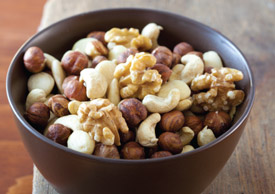We're nuts about nuts
This article was originally published in December 2011

Sweets seem to beckon everywhere we turn this time of year, from the office to a neighbor’s holiday party. Nuts are a perfect snack to ward off those less-healthy temptations: they’re packed with nutrients and can be eaten plain, roasted with virtually any seasoning, or added to salads or other savory dishes.
Of course, there’s nothing wrong with a little healthy indulgence, which is why we love nuts in recipes for sweets for their crunch and flavor. You’ll find a wide variety — from almonds to hazelnuts — in the bulk departments at PCC or in produce, where we sell some nuts from single-origin organic farms. Here are some healthy reasons to enjoy them.
Walnuts
The form of vitamin E (gamma-tocopherol) found in walnuts is unusual and particularly beneficial. This form of vitamin E has been found to provide significant protection for the heart. Walnuts also contain antioxidants not found in any other foods, and unlike other nuts, are rich in ALA, the plant-based source of omega-3 fatty acids.
Almonds
Almonds are one of the most nutritionally dense nuts. They are among the richest sources of vitamin E and provide an array of minerals and antioxidants. There may be more than 20 different antioxidants in almond skins alone! Almonds are richer than eggs in protein — a quarter-cup contains more than 7 grams.
Pistachios
Pistachios are one of the lowest-calorie, lowest-fat nuts and among the highest nuts in antioxidants. They’re an excellent source of B vitamins, copper and manganese, which is important for keeping blood sugar stable, protecting bones and nerves, and helping metabolize fat and cholesterol.
Pecans
Pecans contain more than 19 vitamins and minerals. They also contain different forms of vitamin E called tocopherols, which have been shown to decrease bad (LDL) cholesterol by as much as 33 percent. They’re also a rich source of oleic acid, the same heart-healthy fat found in olive oil.
Hazelnuts
Hazelnuts have the highest content of a plant compound (proanthocyanidin) shown to decrease the risk of blood clots, heart disease, cancer and other chronic diseases. Hazelnuts also rank number one in a B vitamin (folate) essential for preventing birth defects and may help to reduce the risk of heart disease and depression.
Did you know?
Doctors and herbalists once used hazelnuts to treat the common cold, persistent coughs and even baldness. Explorers Lewis and Clark recorded eating native hazelnuts on their journey. Nearly all domestic hazelnuts are grown in Oregon and Washington.
Cashews
Like pecans, cashews are a very good source of the beneficial fat oleic acid and minerals such as copper, phosphorus and magnesium, which is important for bones, muscles, and stable blood pressure.
Aren’t nuts fattening?
You may be surprised to learn that eating nuts actually is associated with weight loss! A study in the journal “Obesity” found people who ate nuts at least twice a week were much less likely to gain weight than those who almost never ate nuts.
Nuts for health
- According to the Food and Drug Administration, eating about a handful of nuts a day may reduce the risk of heart disease.
- The plant sterols and “good” fats in nuts — monounsaturated and polyunsaturated fats — are believed to lower “bad” (LDL) cholesterol levels.
- Nuts are a source of l-arginine, a nutrient that may help prevent blood clots.
- Much of the antioxidants in nuts is in their skins — for example, that’s where about 90 percent of the antioxidant-rich phenols in walnuts are stored.
- Most nuts contain a good supply of vitamin A and B vitamins.
- Many nuts contain vitamin E, which is important for preventing plaque in arteries and is good for skin, hair and nails.
- Many nuts are high in potassium, calcium and magnesium, minerals important for healthy blood pressure. In multiple studies, these minerals have a much greater impact on blood pressure than salt.
Nuts for protein
- Nuts are protein-rich but they’re not “complete” proteins because they don’t contain all the amino acids.
- Combining nuts with grains, beans or vegetables such as greens or broccoli with other amino acids creates a “complete” protein. It’s not necessary to eat these foods at the same time — just in the same day.
- Unlike protein from animal sources such as meat and eggs, which have an acidic reaction on the body, most nuts have an alkaline reaction. (Walnuts, peanuts and hazelnuts are exceptions.)
